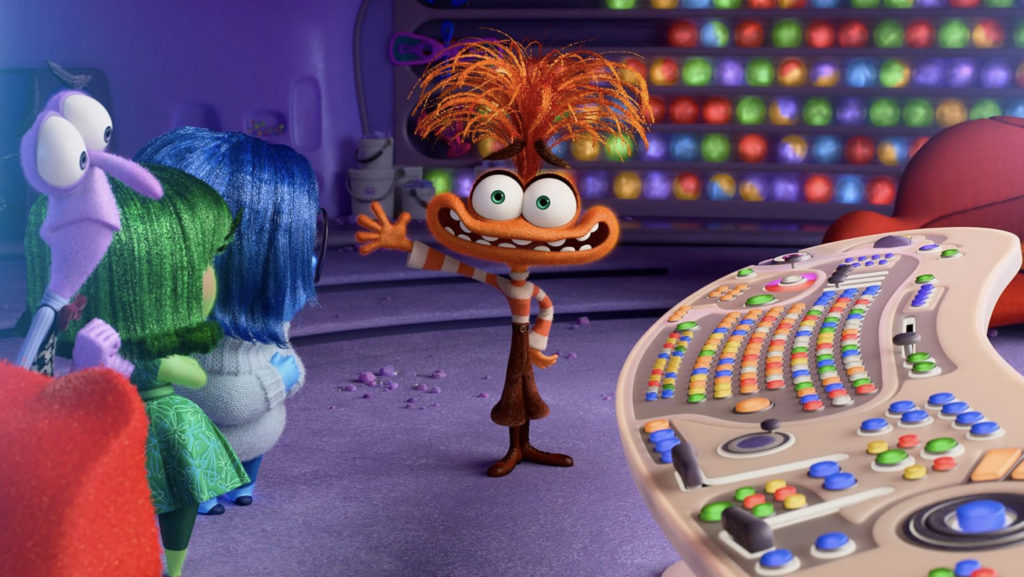The human mind is like a telescope: perfect for observing everything but itself. Quantum physics is grade-school homework compared to decoding the difficulty of asking out a girl who is interested in you — scientists would pool their Nobel prize money for a way to crack that particular nut.
To put it another way: Each generation has its own metaphor to explain why, for all our intelligence, we remain such hot messes. Humors, icebergs, Greek kings, even a ridiculous thing called “neurons.” Today’s artificial intelligence experts insist the brain is a computer, but anecdotal evidence suggests the brain remains far more capable at spotting stop signs in a photo.
Pixar’s latest creation, “Inside Out 2,” has found its own symbol of psyche pertinent to our moment: the work committee.
Like the 2015 original, “Inside Out 2” (released in theaters June 14) depicts each person as governed by five personified emotions: Joy, Sadness, Anger, Disgust, and Fear, who operate at a command center inside the brain. Peering through your eyes, they determine the appropriate emotional response and catalog memories from those experiences. Those memories form a tree like Sense of Self, the manifestation of one’s belief system.
This brain belongs to Riley, a 13-year-old girl recently moved to San Francisco from Minnesota. Like most of our friends from the land of Ten Thousand Lakes, Riley loves hockey and is on her way to a training camp. Riley is also just embarking upon puberty, translated here as a blaring siren alarm and contractors swarming in and making a mess during construction. (A brief aside to thank the Pixar team for having the foresight to make Riley a girl. An exploration of male puberty would be a short film and a horror one at that.)
This is already a delicate and smelly time, but to make matters worse Riley learns her new friends won’t be attending high school with her next year. What started as a mere hockey camp is now an audition for new friends and a new identity. Through these cracks muscles in a new team of emotions: Envy, Embarrassment, Ennui, all following the lead of Anxiety.
Anxiety, though understandably caffeinated, seems to get better results than Joy, which gives her the courage to jettison the original emotions and Riley’s Sense of Self. Those emotions try to return to headquarters and restore the original Riley, before Anxiety rebuilds a whole new one based on desperation and self-hatred.
All of this is well orchestrated. After all, the Pixar machine is too well-oiled by now to deliver a bad product. The cacophony of sniffles I heard in the theater suggests that if you called your parents in the car driving home after the last film, you will call them again. But as Joy herself says in the film, as you get older you have less need for her.
I confess I’ve always had an issue with the central premise of “Inside Out,” which suggests we are but puppets of our own emotions, the governing force rather than a flavor. If the Self careens so wildly based on how you’re feeling at the moment, there isn’t much there to begin with. We’ve all run into people ruled entirely by their emotions — usually in sandboxes or in line for Pixar movies. Riley is young but she is not a toddler, and while we can’t choose how we feel, the lesson should be how to control those emotions, not to merely ride the wave. (Such suppression might give me an aneurysm at 35, but my emotions will go down with my ship knowing I was the captain.)
Moreover, none of us feel one distilled emotion at a time. How often are we embarrassed of our envy, or disgusted of our anger, or maybe just sad about all of it. Too often emotions are a toxic tag team rather than a singular grudge match.
As Steve Larkin of the Washington Review of Books pointed out in his review of “Inside Out 2,” the new emotions arriving with puberty are not that new at all, and don’t signal heightened maturity. St. Augustine proved as much with his pilfered pears: children are complicated in their simplicity. Hormones don’t introduce children to the concept of envy, the serpent got there first.
But the fatal flaw of “Inside Out 2” is how it tries to replay the structure that worked so well in the first film without an understanding of why it did. (I don’t care about spoilers, take it up with Anger.) The first “Inside Out” was about the reconciliation of Joy and Sadness, with the former learning that a healthy person needs the latter to process life. Happiness means nothing without grief in contrast, and pretending sadness doesn’t exist is the quickest way to create a basketcase.
“Inside Out 2” tries to replicate that journey with Anxiety, despite her almost sending Riley off the deep end once more. Anxiety is forgiven and given a place among the council of emotions, even her own special recliner when she gets too hectic. But anxiety isn’t a core emotion. It’s a malady, a disordered response to our helplessness. Anxiety isn’t a moral failing, and thinking so is yet another permutation of its grip. Yet it remains a maladjusted response to the problem at hand, more deserving of a trap door than a place at the table.
Anxiety lies to us, not by saying that problems don’t exist, but implying that it can control them. The worse you feel, the more you cling to the illusion — like a sick cycle of job security. In an increasingly precarious world, true serenity comes not from hiding or collaborating with those fears, but accepting it isn’t all on you. To think otherwise is vanity, a character I’m sure will appear in “Inside Out 3.”

